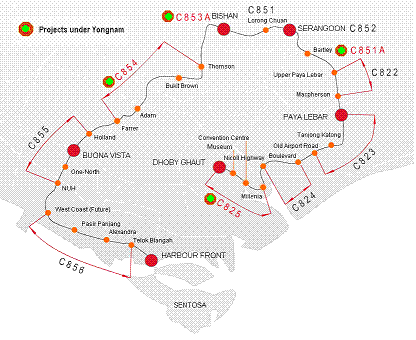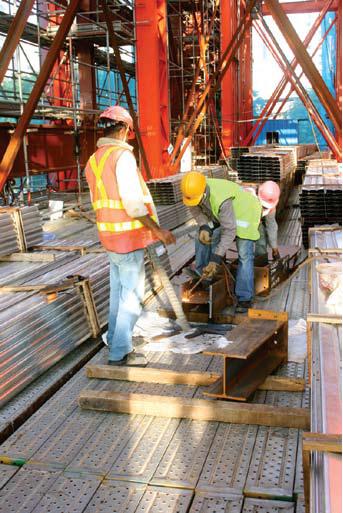Budget 2009 update: The Government will increase public sector construction spending to between $18 billion and $20 billion in 2009 - much higher than the $15 billion in 2008 and $6 billion in 2007.

CONSTRUCTION DEMAND in 2008 reached a record high of S$34.6 billion, up a whopping 41% from Singapore's previous record set in 2007 of S$24.6 billion.
This searing hot expansion led to worries of burgeoning construction costs and a strain in resources in the sector.
As recently as July 2008, the Singapore government announced that it would defer infrastructure spending, including the main building of the proposed Jurong General Hospital. To date, a total of $4.7 billion worth of public sector projects have been deferred to 2010 and beyond.
But with the onset of the financial crisis, and the economic downturn, things look set to change.
Already 3Q08 figures from the Ministry of Trade and Industry are showing a slowdown. The construction sector’s GDP growth shrank from 19.8% in 2Q08 to 12.8% in 3Q08.
What does it mean for the construction stocks whose revenue and operating profits are mainly derived locally?

Public spending to offset fall in private construction demand
A recent survey of financial analysts conducted by the Monetary Authority of Singapore revealed that the general consensus was that construction activity is expected to expand relatively strongly in 2009.
However, one should guard against being too optimistic. Mr. Mah has already said that the “primary concern is to bring back projects to help smaller contractors”.
According to DP Information Group’s analysis of the audited results of 2,000 construction firms, a significant number of firms have excessive debt, weak levels of liquidity and profitability.
Thus, the beneficiaries of the government’s expansionary plan may not be the listed construction firms but the small privately held ones, according to Mr Mah.
Public sector projects contributed 42% to construction demand in 2008, according to a BCA statement released last week.
In the face of the global economic recession, BCA foresees public sector spending increasing to 67%-77% of total construction demand in 2009, which is expected to fall to $22 billion to $28 billion.
"To sustain the flow of jobs to small and medium construction firms, the government will bring back some of the smaller public sector projects, of up to $50 million in value, that were earlier deferred to ease the pressure on construction resources," said Mr Mah in his speech at a BCA-REDAS seminar last week.
Public sector construction demand this year is anticipated to increase to between $17 billion and $19 billion, largely fuelled by infrastructure projects such as the MRT projects (Downtown Line, the North-South Line Extension and Jurong East Connection) and major road projects.
Other major public sector projects to be awarded will include new HDB flats to meet the ongoing demand for public housing, redevelopment of the Singapore General Hospital Pathology Education Research Building and National Heart Centre, as well as the new International Cruise Terminal.
Further details will be released today in the Singapore Budget.
Note that prices of raw materials are still relatively high despite showing signs of retreat. Investors should also look out for listed construction companies that consistently keep a tight rein on their costs.
Investors should also keep an eye out for companies possessing a strong track record in the public sector construction activities, strong balance sheet and low receivables risk.
BBR, KSH, Yongnam to benefit from public spending
Readers might want to take a closer look at BBR Holdings (DMG & Partners “Hold”, TP $0.045), KSH Holdings (SIAS Research “Buy”, TP $0.29) or Yongnam Holdings.
These companies are likely to benefit from the expansionary 2009 Budget, giving some visibility to their earnings in an environment with weakening construction demand and enabling them to emerge from this recession intact.

Structural steel fabricator Yongnam’s local track record includes high-profile projects such as Suntec City Exhibition and Convention Centre, MRT Circle Line and Changi Airport Terminal 1.
Peaking at 56.5 cents in 2007, Yongnam’s share price has tumbled as the financial crisis unfolded. Its last closing price of 9.5 cents (Wed 21 Jan) translates into a historical price earnings ratio of 4X.
If Yongnam is suffering from the effect of a recession, its order book sure isn’t showing. The company’s total order books stood at $247.2m as at 30 September 2008, up 52.6% from $162m in December 2007.
The company announced last Fri its single largest contract to-date, valued at S$185.5 million, for Singapore’s new expressway, the Marina Coastal Expressway.
Last month, the company announced that it won a $88 m contract for the construction of the Integrated Civic, Cultural, Retail and Entertainment Hub at Vista Xchange, one-north, in Buona Vista.
Work on the project has commenced in December 2008.
The win came hot on the heels of a $23.8m Integrated Resort’s order in November – its 7th successive contract from Marina Bay Sands Integrated Resort.
Yongnam capped FY07 with its best ever performance. Earnings rose 360.6% to a record $24.6m on the back of a 15.8% gain in revenue.
The structural steelworks division accounted for a whopping $122.6m of total sales attributable to the completion of the projects such as Alexandra Bridge and Sitronic Wafer Plants. Last year, 2008, looks even better – net profit attributable to shareholders topped $24.7m for the first nine months.
Both structural steel and civil engineering divisions registered strong growth as several key projects such as the New Delhi International Airport and Marina Integrated Resort kicked off.
The company’s balance sheet remains robust with total assets of $372.2m versus liabilities of $235.2m.
In addition, shareholders funds increased to $137m from $108.6m in December 2007, allowing the company to absorb any unexpected losses.
Presently, Yongnam has yet to register any negative effect from the economic crisis.
The risk of project cancellation is low as most of its orders are from the government. In a recent interview with Reuters, the company was reported to be eyeing $1b worth of contracts this year.
Coupled with lower steel prices and labour costs, Yongnam could hand in a better report card next year.
Recent story: TAT HONG is top construction pick of Credit Suisse
Originally published at www.sharesinvestment.com, this article has been updated and is published here as part of a collaboration with NextInsight.








Comments